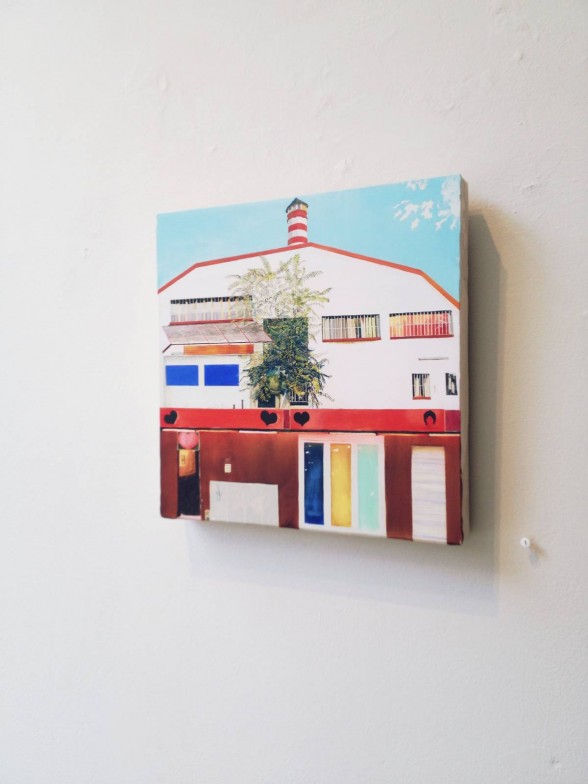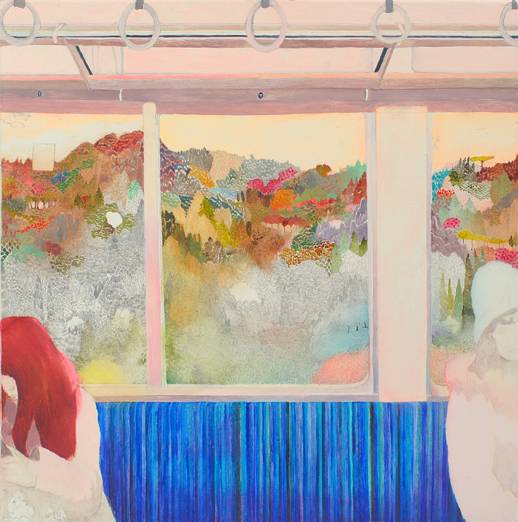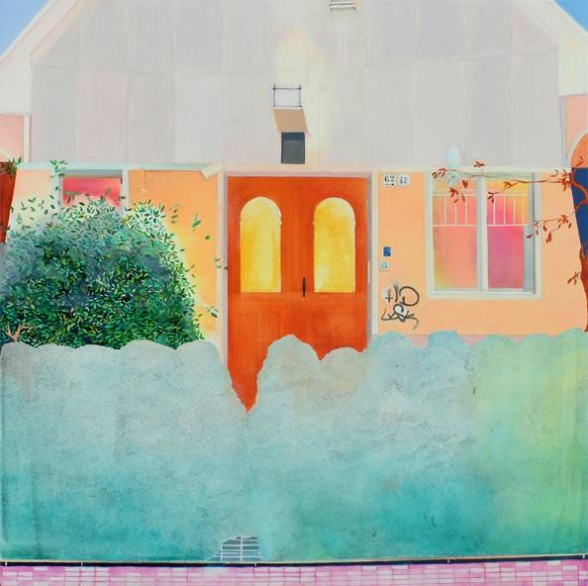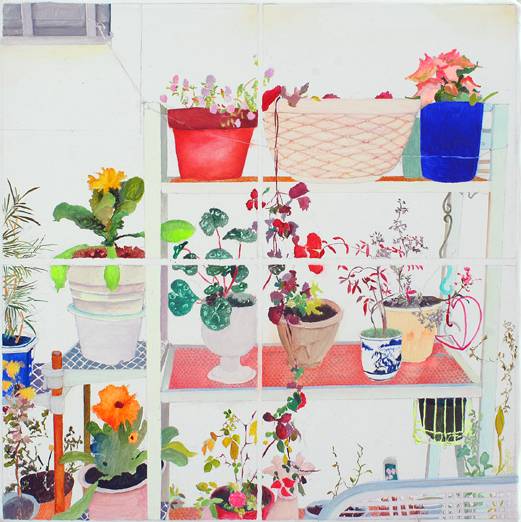Gallery Review
Just about a block up, the Seraphin Gallery, located at 1108 Pine Street, is heard on the streets of Philadelphia to be one of the finest galleries in Philly. Although it is a small gallery, artists like Pheobe Adams, who has showcased her work in the Guggenheim Museum, has also exhibited her work at Seraphin Gallery. Sidney Goodman, another artist known to Philadelphians, has also showcased his work in this pristine, high quality yet unpredictable gallery.
In fact, Lorraine Seraphin, the Associate Director of Seraphin Gallery, has heard people say they love to come to the gallery because they never know what to expect when they walk in. The gallery has housed everything from traditional paintings to contemporary and post-modern abstract work to installation art (art using different kinds of media such as string, chairs, etc.) to photography and sculpture. Lorraine even remembers when 2000 pounds of dirt was delivered to the gallery in the middle of winter for one of their exhibitions. That is one of the aspects that Ms. Seraphin likes about the job. She commented, “There is always something new and exciting to see. I just keep learning every single day.”
-Article from Washington Square West
______________________________________________________________
Artist Reviews
Hiro Sakaguchi - ARTnews
______________________________________________________________
Exhibition Reviews
Good Waste Management
Sunday, June 28, 2015
Seraphin Gallery smartly asked one of its artists, Hiro Sakaguchi, to organize a summer show.
The result, “Debris,” was likely initially inspired by the work of two other Seraphin artists, Joan Wadleigh Curran, who paints still lifes of debris she finds in Philadelphia, and Kelly Wallace, an artist based in London, Ontario, whose pencil drawings depict real and imagined landscapes that appear composed of mountains of rubble and houses in the process of ruination. But with the additions of Brent Wahl, Sherif Habashi, and himself, Sakaguchi offers a broader view of the stuff that piles up, including memories.
Wadleigh Curran’s four paintings, all from 2015, show her using more colors together, painting more expressionistically, and portraying odder perspectives of windblown trash.
I’d seen Wahl’s photographs of debris arranged on black surfaces before (they’re all from 2012), but they certainly belong in this show. His careful organizations of the trash and refuse he finds and collects at various sites in the city elevate these castoffs to a mysterious beauty.
At first, Sherif Habashi’s calligraphic paintings on paper struck me as the least debris-related of the works in this show, because his lines are so delicate and reminiscent of Sufi painting. But the expressionistic doodles he paints also have something in common with hobo symbols and graffiti. And his faint Self-portrait with cinderblock motif looks like an impression, something left behind.
Sakaguchi’s paintings hadn’t ever made me think specifically of debris until I saw his painting and drawing in this show, both titled Preparation for Spring. In both, what appear to be cherry trees wrapped in burlap waiting to be planted are plonked atop an urban landscape reduced to a rubble of infrastructure that includes children’s toys. It suggests a child’s memory of an event as revisited years later in a nightmare. The atmosphere is Pepto-Bismol pink, thick with dust, and undoubtedly toxic.
Though tiny and rendered in pencil, Wallace’s similarly ominous drawing of imploding row-houses, Sticks nstones, also seems to have emanated from a child’s view of a long-ago event.
Seraphin Gallery, 1108 Pine St., 10 a.m. to 5 p.m. Wednesdays through Sundays. 215-923-7000 or seraphin.squarespace.com. Through July 12.
-Article from The Philadelphia Inquirer, click here for link
- - - - - - - - - - - - - - - - - - - - - - - - - - - - - - - - - - - - - - - - - - - - - -
Anne Canfield at Seraphin Gallery
December 19, 2014
[Irena gets up close and personal with a very detailed show of dreamy oil-on-panel works. — the artblog editors]
When painting in the small-scale, it often takes an ounce of something extra to capture an art audience’s attention, even at the local level. Moore College graduate Anne Canfield manages to do just that in her solo exhibit at Seraphin Gallery.
Canfield’s knack for creating imaginative, yet genuine pieces is a special find in the growing flurry of Philadelphia’s contemporary art scene, and places the painter on the who-to-watch list of promising Philadelphia artists.
Exploring memory and awareness
From deconstructed architectural motifs to dreamscapes blurred with reality, Canfield paints landscapes, still lifes, and interiors in a heavily psychological and near-Surrealist manner. The exhibit, entitled Fugue State, deals with perceptions of reality mixed with perceptions of self.
“Fugue” is defined as a reversible loss of memory and awareness of one’s own identity, often as a result of changing environments or situations. The theme of the fugue state is carefully entwined within each of Canfield’s pieces. Canfield, a Philadelphia resident, paints scenes from travel and observations of places of residence in ways that obscure the line between what is real and what is personally perceived. In the colorful and wistful “Train Ride to the Sacred Mountain,” Canfield’s mountains, seen from a train window, are technicolored and barely of this world.
Cinematic influence and subjective interpretations
Canfield’s work is reminiscent of that of PAFA graduate and Philadelphia artist Sara McEneaney, in that both women render distorted perceptions of possible realities and vague references to subconsciousness in interior and exterior scenes.
While McEneaney often offers the viewer self-portraits within her pieces, however, Canfield rarely depicts herself in any of her works. This is most likely because Canfield’s paintings are viewpoints from her own perspective and memory, rather than direct scenes viewers are looking into.
Canfield takes inspiration from early Netherlandish painters and Indian miniatures: references that can be observed in the whimsical detailing of her works. She is also highly interested in film, especially Italian cinema, which offers subjective interpretations of truth. Canfield cites Fellini as a muse in her artist statement, and like the legendary director, she manages to blend reality and surrealism into one experience.
It is often unclear whether Canfield’s scenes are true to life or figments of her imagination, although it can be safely assumed they are overlaps of both. In certain pieces, such as “Good is What Pleases,” two different scenes are molded together to create a single “other-space”.
The questionable authenticity of Canfield’s interpretations is what makes the entire show a literal “Fugue State”. As gallery owner Lorraine Seraphin put it during our interview at the gallery: “Anne’s works are based on real-life experiences and scenes, but she has manipulated them, made them inventive, and in many cases, surrealistic.”
Canfield’s unusual pieces incorporate bright, saturated, non-representational colors and very thin, careful lining. Canfield happens to be very nearsighted and takes off her glasses while she paints. Perhaps this explains the level of refinery in the tiny, carefully planned detailing. Such painstaking work can be observed in the highly surreal “The Blue Bird,” and in “Euphoria No. 1 and 2,” a set of paintings portraying a potted-plant arrangement.
Anne Canfield’s colorful narratives successfully demand the attention of the viewer, despite their very small scale; it is nearly impossible to walk through her exhibit and not want to carefully study each meticulously crafted painting. Her pieces are windows into complicated psychological states and anxieties, but at the same time offer peaceful nostalgia and whimsicality.
Fugue State is on view at Seraphin Gallery,1108 Pine St., Philadelphia, PA, through Jan. 11, 2015.






